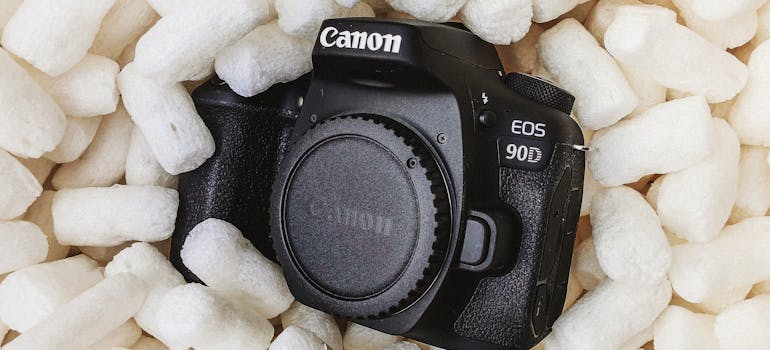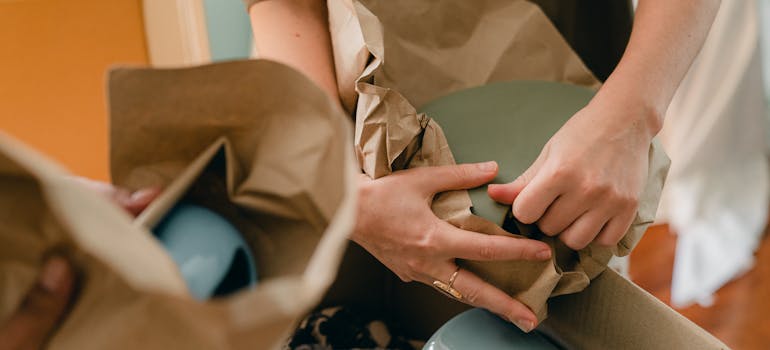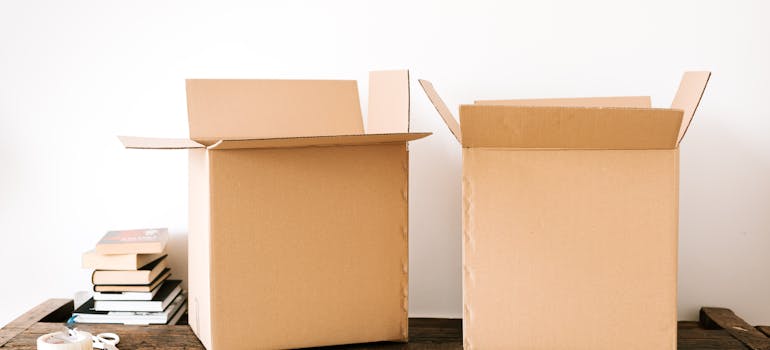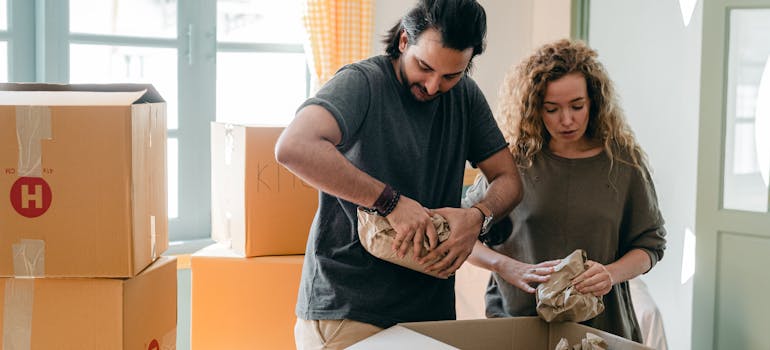Moving is always a bit stressful, but it becomes even more challenging when you are trying to safely move fragile items. Whether it’s your grandmother’s antique vase or your collection of delicate glassware, making sure these items arrive at your new home intact requires careful planning. Luckily, there are straightforward tips that can help you protect your most fragile belongings during a move. These tips are designed to make the process easier and to give you peace of mind knowing your valuable items are safe.
Select the right packing materials
Choosing the right packing materials is the first and most important step in ensuring that your fragile items are protected during a move. The materials you use can make a significant difference in how well your items are cushioned against bumps and vibrations. According to the long distance movers DC area provides, using high-quality packing supplies is extremely important. It matters even more when moving delicate items over long distances.
A list of essential packing materials you should consider
There are many packing materials you will find once you start looking, but these are the ones that should be on the top of your list:
- Sturdy boxes: Choose strong, corrugated cardboard boxes that can withstand the weight and protect the contents inside. Avoid using old or weakened boxes.
- Bubble packs: Use bubble wrap to cushion fragile items like glassware, ceramics, and electronics. The air-filled bubbles provide a protective layer that absorbs shock.
- Packing paper: Wrap items in packing paper to prevent scratches and add a layer of protection. It’s also great to fill the empty spaces between items in boxes.
- Packing peanuts: Use packing peanuts to fill gaps in boxes, ensuring that items don’t move around during the move.
- Furniture pads: Protect larger items like mirrors, artwork, or furniture with padded blankets or furniture pads to prevent dents and scratches.
- Tape and markers: Secure your boxes with strong packing tape, and label each box clearly with its contents and handling instructions.

Use proper wrapping techniques
When it comes to moving fragile items, how you wrap them is just as important as the materials you use. According to the experience of the trustworthy moving companies DC area has to offer, taking the time to wrap each item properly can make all the difference.
Double wrap to safely move fragile items
For particularly delicate items, like glassware or porcelain, it’s a good idea to double-wrap them. Start by wrapping each piece in packing paper to create a protective layer. Once wrapped in paper, add a layer of bubble wrap for additional cushioning. This method provides two layers of defense, helping to absorb any shocks or bumps during the move.
Securing the wrapping with tape
After wrapping your items, be sure to secure the packing materials with tape. This prevents the wrapping from coming loose and exposing your fragile belongings to potential damage. It’s important to use enough tape to keep everything in place without overdoing it, as excessive tape can make unpacking more difficult.
Avoid gaps and loose ends
When wrapping, make sure there are no gaps or loose ends. Any exposed part of the item can become vulnerable during the move. Tuck in the edges of the wrapping material and secure it firmly, ensuring that the item is fully protected from all sides. This attention to detail can greatly reduce the risk of breakage during transit.

Choose the right box size
Bigger is not necessarily better when it comes to boxes. Selecting the right box size when moving fragile items is another task you’ll have to handle. With the right box, you’ll ensure your items are well-protected and secure during the move. In case you are using the moving services DC or some other area offers, you don’t have to worry about this. However, if you’re packing on your own, here are some key points to consider.
Avoid overpacking or underpacking
When packing fragile items, it’s essential to avoid both overpacking and underpacking your boxes. Overpacking can put too much pressure on your items, increasing the risk of breakage. On the other hand, underpacking leaves too much space, allowing items to shift during transit. The best approach is to fill the box just right, with enough cushioning materials to prevent any movement.
Use appropriately sized boxes
Choosing the right box size also means selecting a box that matches the size of the items you’re packing. Smaller boxes are ideal for heavy, fragile items like dishes or small electronics because they reduce the likelihood of the box becoming too heavy to carry safely. Larger boxes can be used for lighter, bulkier fragile items, but make sure to fill any empty spaces with packing materials to prevent items from shifting.
Consider specialized boxes
To safely move fragile items such as glassware or artwork, consider using specialized boxes. These boxes are designed with built-in dividers or additional padding to offer extra protection. They might cost a bit more, but they provide peace of mind knowing that your most delicate belongings are safe.

Transport fragile items separately
Transporting your fragile items separately from the bulk of your belongings can greatly reduce the risk of damage. Namely, when you keep these delicate items in your vehicle or set them aside for special handling, you ensure that they are less likely to be jostled or mishandled during the move. Local movers in DC often suggest this approach to minimize the chances of accidents during transit.
Tips for transporting fragile items separately
Those who are new to this task should pay attention to the following:
- Identify the most fragile items. Set aside items like glassware, mirrors, electronics, and heirlooms that need extra care.
- Use a sturdy container. Choose a box or container that fits your fragile items snugly and provides adequate protection, such as a plastic bin with padding.
- Secure the items inside. Make sure the items are well-wrapped and cushioned inside the container to prevent movement during the drive.
- Keep the box upright. Ensure that the box stays upright during transport to avoid putting pressure on delicate items.
- Place in a stable position. Put the container in a stable part of your vehicle where it won’t shift around during the trip.
- Monitor during the move. Keep an eye on the container during the drive to ensure nothing has shifted or been damaged.
Fill empty spaces in boxes
Empty spaces inside boxes can be a big problem when moving fragile items. These gaps allow your items to shift during transit, which increases the risk of damage. DC apartment movers often point out that taking the time to properly fill these spaces can make a significant difference in keeping your belongings safe.
Use packing materials to fill gaps
The most effective way to fill empty spaces is by using packing materials like bubble packs, packing peanuts, or crumpled paper. These materials cushion your items and prevent them from moving around inside the box. Be sure to fill all gaps, no matter how small, to provide maximum protection.
Pack tightly but not overly compressed
While it’s important to fill empty spaces, avoid compressing your items too tightly if you want to safely move fragile items. Packing too tightly can put pressure on fragile items, causing them to crack or break. Instead, aim for a snug fit where the items are secure but not overly compressed. This balance ensures that your items are protected without being subjected to unnecessary stress.
Check for movement before sealing
Before sealing a box, give it a gentle shake to check for movement. If you hear or feel items shifting, open the box and add more packing material until everything is secure. This simple step can help you catch potential problems before they become bigger issues during the move.

Consider custom crating for extremely fragile items
For highly delicate or valuable items, custom crating can provide an extra layer of protection during a move. Whether it’s an antique mirror, a piece of artwork, or a musical instrument, custom crating ensures that these items are secure and well-protected. This is something professionals for specialized transportation, such as DC piano movers, know well and often point out.
What is custom crating?
Custom crating involves building a wooden crate specifically designed to fit your item. These crates are tailored to the dimensions and shape of your fragile belongings, offering a snug and secure fit. The inside of the crate is often lined with foam or other cushioning materials to absorb shocks and prevent movement during transit.
When to use custom crates to safely move fragile items
Custom crating is particularly beneficial for large, heavy, or unusually shaped items that can’t be adequately protected with standard packing materials. For example, if you’re moving a piano, a custom crate can protect it from external pressure and accidental bumps. Similarly, custom crates are ideal for valuable artworks or other irreplaceable items that require extra care.
Ensuring proper construction
If you decide to use custom crating, make sure the crate is constructed by professionals who understand the specific needs of your items. A well-built crate will have reinforced corners, secure closures, and ample padding inside. This attention to detail ensures that your fragile items remain safe throughout the entire moving process.

Pack heavier items at the bottom
When packing fragile items, the way you organize them within the box can significantly impact their safety during the move. As mentioned before, placing heavier items at the bottom is a very effective strategy to prevent damage. This is a practice commonly used by respected residential movers in Washington DC and other cities. In fact, it’s one of the reasons these companies have such a good track record of transporting delicate pieces safely.
Effectively packing heavier items at the bottom – step by step
This is how you should properly pack your heavier stuff:
- Start with a solid base. Place the heaviest items first to create a solid foundation.
- Distribute weight evenly. Spread out heavy items evenly across the bottom of the box to avoid any one area from bearing too much weight.
- Layer Items thoughtfully. Place medium-weight items on top of the heavy ones, followed by the lightest and most fragile items at the very top.
- Use cushioning between layers. Add padding, like bubble packs or packing paper, between layers to absorb shocks and prevent movement.
- Avoid overloading. Ensure that the box isn’t too heavy to lift safely, as dropping it could damage the contents inside.
When packing fragile items, you must pay attention to the weight distribution within each box. Placing heavier items at the bottom is a fundamental rule that helps protect more delicate items from damage during the move. For example, Washington DC movers have noticed that improper weight distribution often leads to unnecessary breakage.
Prevent crushing by layering
When you start packing, place the heaviest items, such as books or sturdy kitchenware, at the bottom of the box. This creates a stable base and prevents lighter, more fragile items from being crushed. After the heavier items are in place, you can layer lighter and more delicate items on top, ensuring they aren’t exposed to the full weight of the box’s contents.
Use padding between layers
To further protect your fragile items, add padding between the layers. You can use bubble packs, packing paper, or even soft items like towels or linens. This added cushioning helps absorb any shocks and keeps the layers of items from pressing against each other.
Avoid overloading boxes
Even with careful layering, it’s important not to overload your boxes to safely move fragile items. Keep them manageable in weight to reduce the risk of dropping them during the move. Additionally, heavy boxes are more likely to get mishandled, which could damage the fragile items inside. Ensuring a balanced weight across all your boxes will make the move smoother and safer for your belongings.

Protecting your fragile items during a move
In essence, to safely move fragile items, it is important to take the time to pack them with care. That way you will ensure they arrive safely at your new home. By using the right materials, packing them correctly, and handling them with care, you can minimize the risk of damage. Remember, a little extra effort in packing can save you from the disappointment of finding your treasured belongings broken. Following these tips will help make your move smoother and less worrisome.


